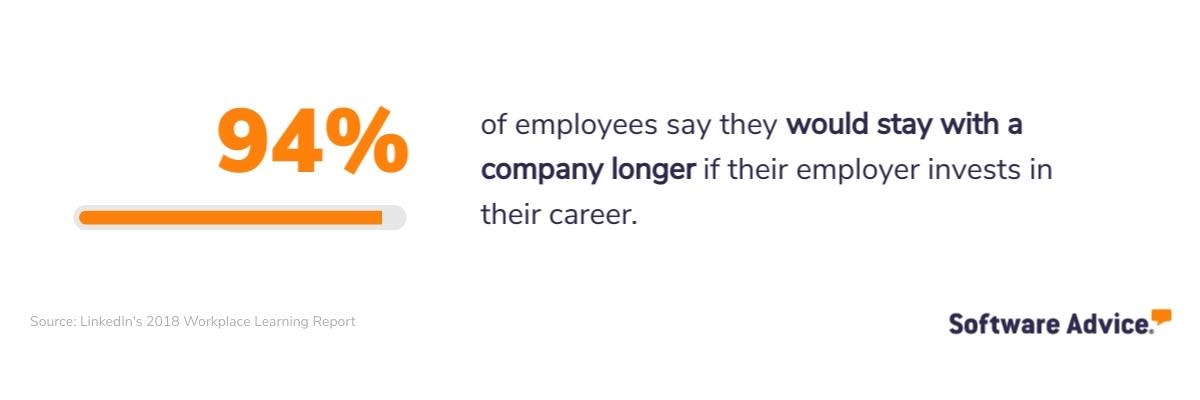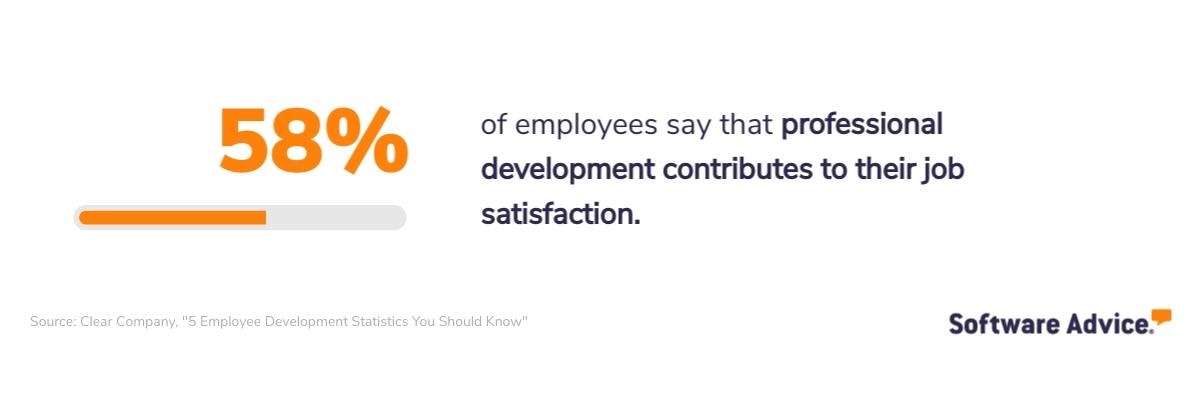The Advantages of Internal Recruiting Will Make You Consider Changing Your Hiring Strategy
In our Recruiting Strategy Survey[*], Software Advice asked 300 employees with recruiting responsibilities how long it’s currently taking them to fill open roles. Fifty-three percent of respondents said it was taking longer than usual, with an additional 9% stating that it was taking the longest amount of time they’ve seen during their tenure.
As a recruiter, you likely know that this is because of the ongoing talent shortage. In fact, 75% of companies have reported talent shortages[1] and difficulty hiring during the last year.
And while we can’t snap our fingers and end the talent shortage in order to make recruiting quality hires and filling roles easier for you, what we can do is inform you about strategies that will help you fill roles and save valuable recruiting resources (such as time and money)—starting with internal recruiting.
If you’re a recruiter or hiring manager who’s looking for strategies to fill roles that you may not have tried yet, this article is for you. We’ll explain what internal recruiting is and give an overview of the advantages you can gain from incorporating this tactic into your own talent management strategy.
What is internal recruitment?
Internal recruiting is a hiring strategy that entails recruiting an existing employee within your organization to fill a vacant role. Promotions, transfers, and moving temporary employees to full-time positions are all the outcome of internal recruiting.
In Outreach Protocols and Eligibility Requirements for Internal Recruiting[2], Gartner reports that 41% of HR leaders indicate their organizations do not have any processes in place for recruiter contact with internal candidates. From this, we can assume that most businesses don’t consider internal recruitment as a formal hiring strategy.
However, considering the four advantages of internal recruiting we’ve listed below, incorporating this strategy into your hiring processes may give your organization an edge over the competition when it comes to filling key roles.
The advantages of internal recruiting for businesses
Better employee retention
According to the Bureau of Labor Statistics[3], the median tenure for wage and salary workers in the United States is approximately four years. Meaning, the average American employee switches careers about once every four years[4], whether that entails leaving one employer for another or being promoted into a different position at their current workplace.
All this to say, if you’d like to lower the chance of your employees jumping ship for a different opportunity, you need to bolster your internal recruiting strategy.

In fact, in Software Advice’s Toxic Culture Survey[**], we ask HR professionals to rank 14 factors that influence their employees’ job satisfaction from most important to least important. Compensation and work-life balance were seen as the most influential, with opportunities to advance their career following closely behind.
This finding tells us just how important career development opportunities are to employees, and considering the intense competition for talent that employers are currently facing, it’s essential that you do everything you can to keep employees from leaving—especially providing opportunities for them to advance their careers.
To do:
Check in with your workforce’s engagement levels in order to identify employees that are at risk of leaving your organization. You can do this by encouraging team managers to communicate with their direct reports one-on-one, or you can run a company-wide employee satisfaction survey that prompts workers to assess their own engagement level and the factors that influence it.
Lower recruiting costs
Typically, the expenses associated with placing an internal hire in a new role are much lower than those incurred through external recruiting. Glassdoor[5] estimates that the average cost of an external hire is around $4,000, while it typically costs only $1,000[6] to hire an internal candidate.
This is because with external recruitment, your organization may need to spend money on things such as promoting open positions on job boards, sourcing candidates from resume databases, or running background checks (all of which would be unnecessary if you opt to recruit an existing employee).
Lastly, the risk of making a bad hiring decision—one that might cause you to have to backfill the role after an early departure—is much lower with internal candidates, because they already have an existing rapport with your organization.
To do:
Calculate your organization’s cost per hire[7]. Cost per hire represents the average recruiting expense incurred for a single new hire, including internal expenditures such as recruiter’s salaries, software costs, and employee referral fees. Once you know your average cost per hire, it will be much easier to measure how much money can actually be saved by placing an internal candidate in a role.
Reduced time-to-hire
According to Fit Small Business[6], it takes between one and three months to fill a role with an external hire, and only two to three weeks to fill a role with an internal hire. This is significant time savings, because as we mentioned at the top of this article, it’s taking the majority of employees with recruiting responsibilities longer than usual to fill open positions.
With external recruiting, there needs to be ample time allotted for sourcing and screening candidates. Contrarily, internal recruiting can help shorten time-to-fill because candidates have already gone through the screening process and are a proven cultural fit. Plus, they likely do not need to go through as extensive of an interview process as an external candidate, because they may be familiar with the department heads in the business unit they’re pursuing a new role within.
Lastly, internal hires will have a shorter, more focused onboarding process than external candidates, because they’re already familiar with your business’s operations and people.
To do:
Configure your recruitment pipeline so that internal candidates are sourced first. Check with department heads to see who on their team might be interested in advancement opportunities. Further, having employees complete an individual development plan (IDP)[8] will make you aware of your workers’ preferred career trajectories ahead of time. Consistently prioritizing this step will add up to significant time savings over the course of the year.
Improved employee engagement
It’s no secret that employees who feel like they’re in a “dead-end job” are going to be less engaged than those who believe there are career advancement opportunities at their employer within reach.
The numbers back this up; Clear Company reports that employees who have access to professional development opportunities are 15% more engaged[9] and a majority of employees feel that professional development influences their job satisfaction.

Whether it’s a promotion or a transition to a cross-functional role, hiring from within your organization communicates to employees that they will be supported when pursuing their career goals with your company. This helps foster a culture where employees know the skills they bring to the table are valued, and in turn, are more likely to be engaged on a day-to-day basis.
To do:
Kick off a career pathing initiative. Career pathing is a talent development strategy that complements internal recruiting and boosts engagement. You can learn more about this tactic in this guide: Retain Talent and Reduce Turnover With Career Pathing[10].
3 disadvantages of internal recruiting to be aware of
As with any business practice, there are some downsides to internal recruiting. In order to make sure you’re fully educated on the topic, we’ve included a concise summary of the main disadvantages cited in conversations about hiring internal candidates.
You’ll be left with an open role to fill: When you opt to fill an open position through an internal promotion, the employee’s original role will need to be backfilled, which may put you in a position to have to go through the external hiring process anyways.
Your company may be at risk of becoming an echo chamber: External hires bring new ideas and a fresh perspective to your company which undoubtedly benefits process improvement efforts.
Your internal talent pool may be limited: If you’re recruiting for a role that requires a specific set of skills that are not already present in your organization, you may have better luck searching for candidates outside your company.
Make internal recruiting a part of your hiring strategy
It’s important to understand that internal recruiting doesn’t need to be your primary recruiting strategy—it just needs to be a part of it. Through enabling your employees’ internal mobility through your organization, you’ll be able to save time and money while filling roles, in addition to boosting employee engagement and retention.
Before you go, check out our tips for incorporating internal recruiting into your talent strategy:
Encourage managers to have their direct reports fill out an individual development plan: An individual development plan (IDP) allows employees to outline their future career goals and plan out the steps they need to take to achieve them. IDPs also make it easier to determine which employees might be interested in pursuing open roles that become available. If you need an IDP template, there’s one available to download for free here[8].
Share open positions through company newsletters, meetings, and internal communications tools: In 4 Best-Practice Applications of Career Pathing Platforms[11], Gartner found that only 27% of employees believe their company makes job opportunities that match their interests easy to find. Whether this is due to talent hoarding or simply the lack of a formal internal recruiting process, it’s something worth improving upon. The best way to start making open roles more accessible to internal candidates is by promoting them through internal communication channels such as company newsletters, meetings, or your organization’s collaboration software.
Evaluate your current HR tech tools: Is your applicant tracking system (ATS) helping you fill roles quickly? Could your organization benefit from a succession planning platform? With nearly 2,500 tools in our HR software category to choose from, there’s no reason to settle for one that’s holding you back. If you need guidance on how to choose software that will give your business an edge, reach out to our expert software advisors. All you have to do is have a short discussion about your business, the features you’re interested in, and your budget, and they’ll recommend five top-rated systems that work best for your unique criteria—free of charge.
Survey Methodologies
* The Software Advice Recruiting Strategy Survey was conducted in July 2021. We collected 300 responses from workers with recruiting responsibilities at U.S. employers. The goal of this survey was to learn how much companies are struggling with recruiting and hiring, and what solutions they’ve considered to improve recruiting and hiring outcomes.
** Software Advice’s 2022 Toxic Culture Survey was conducted in January 2022 among 195 HR leaders at U.S. companies with at least six employees who had transitioned from mostly on-site work to mostly hybrid or remote work. An HR leader is defined as any HR employee with the role of HR manager or higher at their organization. The goal of this survey was to learn how the transition to hybrid and remote work impacted toxic employee behaviors.
Sources
1. The Talent Shortage, ManpowerGroup
2. Outreach Protocols and Eligibility Requirements for Internal Recruiting, Gartner
3. EMPLOYEE TENURE IN 2020 , Bureau of Labor Statistics
4. How Often Do People Change Careers?, Indeed
5. How To Calculate Cost-Per-Hire, Glassdoor, Inc.
6. Internal vs External Recruiting: Timeline, Costs & More, Fit Small Business
7. How To Calculate Cost Per Hire To Optimize Recruiting, Ideal
8. Looking For a Career Pathing Template? The Search Ends Here, Capterra Inc.
9. 5 Surprising Employee Development Statistics You Should Know, ClearCompany
10. Retain Talent and Reduce Turnover With Career Pathing, Capterra Inc.
11. 4 Best-Practice Applications of Career Pathing Platforms, Gartner